Seagulls are omnivorous seabirds that have gotten a bad reputation for being highly opportunistic feeders. Sometimes, they seem to act against their own best interests, such as when they steal foods from larger, more dangerous creatures like beach-dwelling human beings. With such an open mind when it comes to food, it’s only fair to ask, what do seagulls eat?
We’re going to explore the vast array of foods that seagulls prefer and look at what they eat when the weather becomes colder, and they have fewer meals to choose from. Don’t worry too much about their wintertime eating habits, though; these birds can find a meal all year long.
What Foods Do Seagulls Eat?
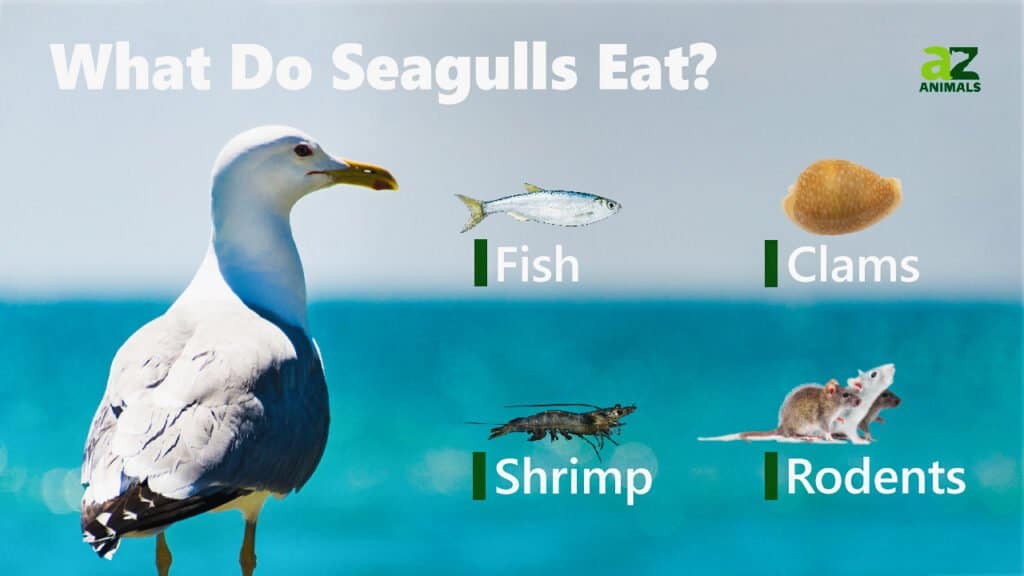
Seagulls eat fish, insects, reptiles, rodents, and many other types of foods. These omnivorous birds are highly effective scavengers and hunters. They often live in colonies ranging in size from a few dozen to several hundred seagulls, and they may forage and hunt for food together.
The foods that seagulls commonly eat include:
- Smaller birds
- Herring
- Mackerel
- Sardines
- Carrion
- Candlefish
- Cod
- Bass
- Tuna
- Crabs
- Squid
- Shrimp
- Smelt
- Potatoes
- Pineapple
- Scallops
- Oysters
- Octopus
- Seals
- Bananas
- Apples
- Watermelon
- Pine nuts
- Pecans
- Bread
- Various processed foods from humans
- Whales (small bites of them).
Needless to say, seagulls are not picky eaters, and they will make a meal of many different types of foods. Some of the things they eat are not even healthy for them, like bread.
For the most part, though, they will eat fish, mollusks, and some invertebrates before considering venturing too close to potential predators for a meal.
How Do Seagulls Find Food?
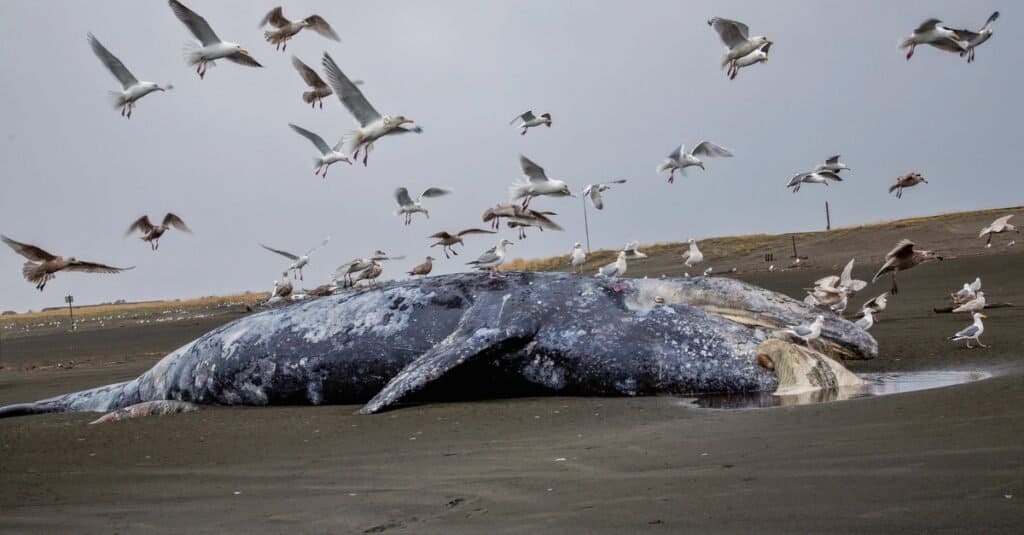
Seagulls easily find food with their sight, smell, and intellect.
©Bob Pool/Shutterstock.com
Seagulls find food by using their intelligence, keen sense of smell, and great vision. Once they locate a meal, it’s often a matter of swooping in and securing it before a competitor, often another seagull, gets there first.
Seagulls have a long bill that is hooked at the end, making them good at hunting and eating fish. Another adaptation that helps them get food is their ability to drink saltwater, one of few birds that can do this and survive. They can go rather far out to sea in search of food without dehydrating.
Although they are generally considered rather dumb and obnoxious birds, the truth is that seagulls are intelligent enough to drop mollusks from great heights to crack their shells, eat foods that humans have touched (possibly because they know it’s safe to eat), and use different foods to bait fish to the surface to eat them.
They have no problems finding food while flying, on land, or in the water. They can often catch and eat insects mid-flight or swoop into the water or down to land if they spot a choice meal ready to be eaten.
Even though these birds are known for hunting in groups, it is every bird for itself once seagulls find a meal. There are no coordinated hunting patterns as one would see in other creatures, like the humpback whale.
What Do Baby Seagulls Eat?
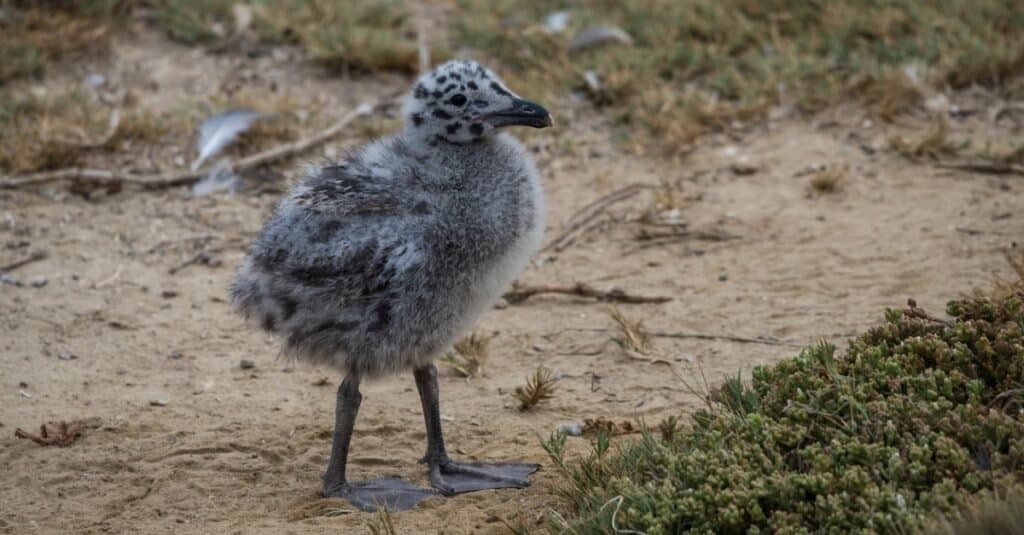
Until they are old enough to hunt on their own, baby seagulls eat their parents’ regurgitated food.
©iStock.com/Bill_Dally
Baby seagulls eat regurgitated food from their parents until they are old enough to go and find food on their own. Seagull chicks are born following 3-4 weeks of incubation, and they are rather helpless and dependent on their parents.
The parents work together to keep the hatchlings fed for the first two weeks of life. During that time, the babies eat what their parents eat via regurgitation. Typically, the mother will continue to brood and protect the baby seagulls while the father goes to find food and bring it back to their nest.
Once the birds fledge, they are ready to go and find food on their own. This process can take between a month and two months, but they continue to stay near their parents for nearly half a year before they move away permanently.
Although baby seagulls cannot hope to eat the same meals as their parents early in life, they assume an adult diet a few months after fledging.
What Do Seagulls Eat in Winter?
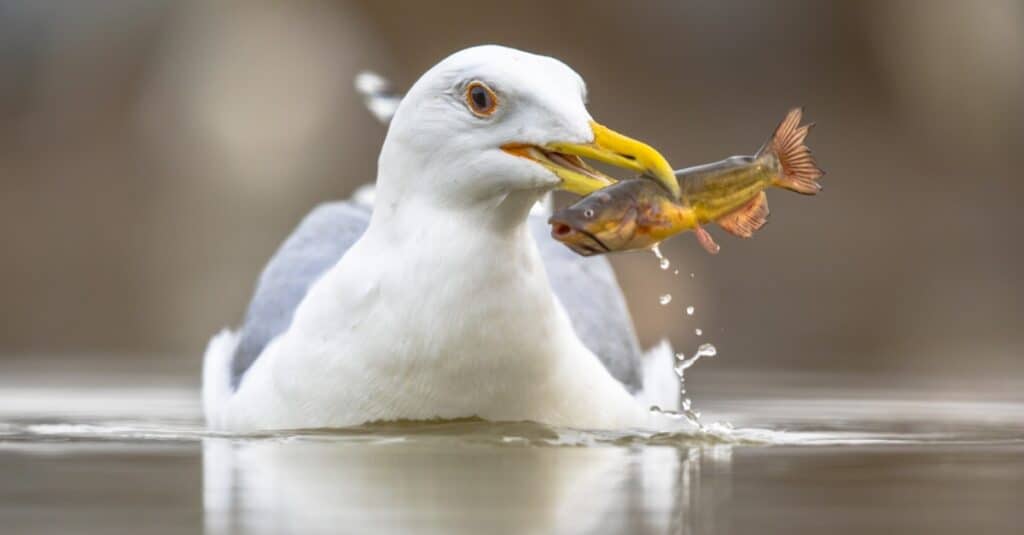
Seagulls eat mainly the same foods during winter, but they will travel to obtain them.
©iStock.com/CreativeNature_nl
The wintertime is not often friendly to creatures that rely on finding prey, but the seagulls pass through this season quite easily. Some seagulls migrate south to warmer waters during the winter, but some of them stay close to their original territory if the winter is mild.
Often, they will move inland to places that are not as adversely affected by winter storms.
During this time, they will continue to feast on:
- Fish
- Small mammals
- Small birds
- Insects
- Suet
- Birdseed
- Various “human foods”
- Organic garbage from humans.
They eat all these foods in addition to the foods from their typical diet that seagulls can find in the winter. Much of what they eat depends on their area. Some seagulls that live in crowded human areas on coastlines or in cities will continue to feast on human food and garbage. The birds that live in more remote areas will focus on eating fish and insects.
What Predators Eat Seagulls?
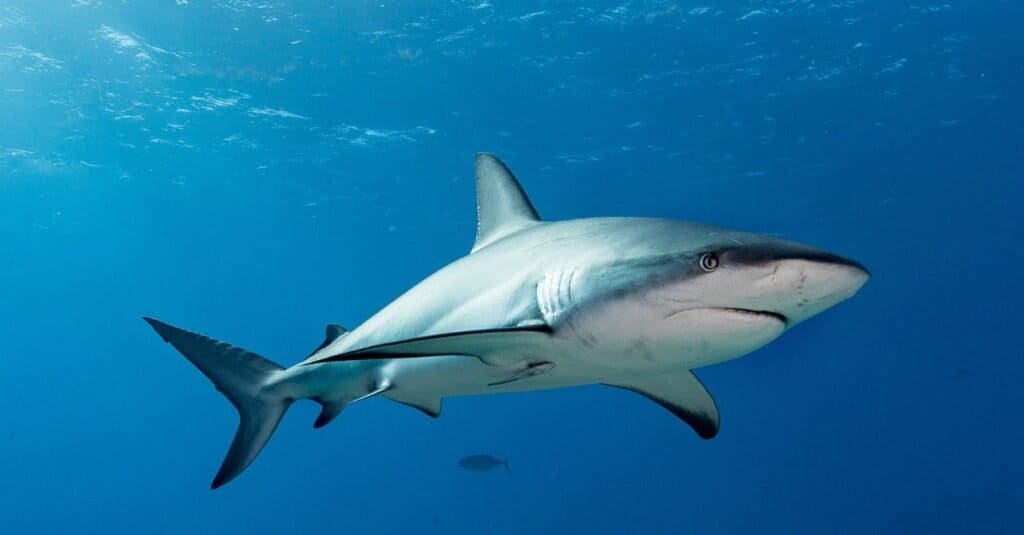
Sharks will often eat seagulls that stop to drink.
©Izen Kai/Shutterstock.com
Although seagulls are quite effective predators in their own right, there is always a bigger, stronger, and hungrier creature that can make a meal of them. As birds that spend time looking for food on the water, in the air, and on land, seagulls are exposed to quite a few predators.
Take a look at the creatures that can effectively hunt and eat a seagull:
- Sharks
- Falcons
- Foxes
- Weasels
- Eagles
- Hawks
- Feral cats
- Octopus.
These are some of the foods that eat seagulls, but you’ll notice it is not a very long list. After all, seagulls are hardly ever alone, so picking one off is difficult. Birds of prey and sharks are very successful hunters, but they do not frequently hunt for seagulls.
It should be no surprise that seagull populations can explode in some areas without a real predator to keep them in check.
Summary of What Seagulls Eat
Seagulls are omnivorous birds that feed on just about anything they can get their beaks around. They eat fish, insects, other birds, small mammals, and much more. Seagulls are a common sight and nuisance for people. They plague hungry beachgoers and trash dumps, alike. However, they fulfill a valuable need of eating the inedible and keeping the population of fish and insects in check.
Here’s a recap of foods they love to eat.
| Number | Food |
|---|---|
| 1 | Various processed foods from humans, including bread |
| 2 | Fish (herring, mackerel, sardines, candlefish, cod, bass, tuna, smelt) |
| 3 | Crustaceans (crabs, shrimp) |
| 4 | Mollusks (clams, squid, octopus, scallops, oysters) |
| 5 | Marine mammals (seals and whales — small bites of them) |
| 6 | Insects |
| 7 | Smaller birds |
| 8 | Rodents |
| 9 | Vegetables (potatoes) |
| 10 | Fruit (pineapple, bananas, apples, watermelon) |
| 11 | Nuts (pine nuts, pecans) |
| 12 | Birdseed |
| 13 | Suet |
| 14 | Carrion |
What Can Seagulls Not Eat?

Seagulls are known to steal food from humans, which is an unusual trait in birds.
©rai/iStock via Getty Images
It may seem as though seagulls can eat everything. I’m sure we all have had one instance where we were happily minding our own business eating a churro or a burrito only to have a seagull swoop in from above and steal it (or maybe that was just me). But there are actually foods that they should not, and can not, eat. A lot of foods have high levels of toxins and can lead to serious issues and even death.
Many of the items on this list are similar, if not exact, to items that you should not give to other animals, like dogs and cats, for the same reasons – high toxicity levels. Here are a few of the more common items that you should never give to seagulls, or any birds:
- Avocado
- Caffeine
- Chocolate
- Fat
- Onions and Garlic
- Salt
You may not be able to control what birds eat in the wild but you can make sure if you are feeding wild birds, you aren’t adding any of these items to the food you may leave out for them.
The photo featured at the top of this post is © iStock.com/jokuephotography
Thank you for reading! Have some feedback for us? Contact the AZ Animals editorial team.






